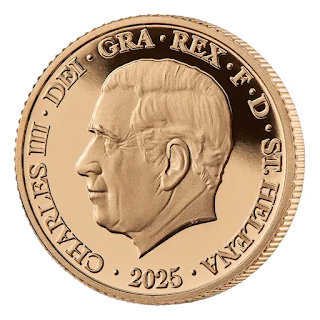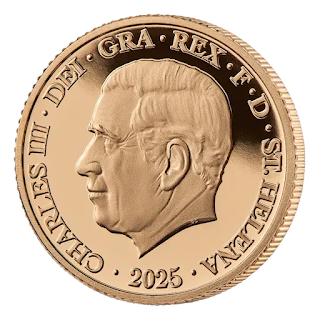3654) A Gold Sovereign Set issued by St. Helena: Coin set minted/retailed by the East India Company: The denominations include -Double, One, Half and Quarter Sovereign: Date/Year of Coin set minting: 2025:
The sovereign is a British gold coin with a nominal value of one pound sterling (£1) and contains 0.2354 troy ounces (113.0 gr; 7.32 g) of pure gold.
Struck since 1817, it was originally a circulating coin that was accepted in Britain and elsewhere in the world; it is now a bullion coin and is sometimes mounted in jewellery.
In addition, circulation strikes and proof examples are often collected for their numismatic value.
In most recent years, it has borne the design of Saint George and the Dragon on the reverse; the initials (B P) of the designer, Benedetto Pistrucci, are visible to the right of the date.
The coin was named after the English gold sovereign, which was last minted about 1603, and originated as part of the Great Recoinage of 1816. Many in Parliament believed a one-pound coin should be issued rather than the 21-shilling guinea that was struck until that time.
The then Master of the Mint, William Wellesley Pole had Pistrucci design the new coin; his depiction was also used for other gold coins.
Originally, the coin was unpopular because the public preferred the convenience of banknotes but paper currency of value £1 was soon limited by law. With that competition gone, the sovereign became a popular circulating coin, and was used in international trade and overseas, being trusted as a coin containing a known quantity of gold.
The British government promoted the use of the sovereign as an aid to international trade, and the Royal Mint took steps to see lightweight gold coins withdrawn from circulation.
From the 1850s until 1932, the sovereign was also struck at colonial mints, initially in Australia and later in Canada, South Africa and India - they have again been struck in India for the local market with the mint mark "I", since 2013, in addition to the production in Britain by the Royal Mint.
The sovereigns issued in Australia initially carried a unique local design but by 1887, all new sovereigns bore Pistrucci's George and Dragon design.
Strikings there were so large that by 1900, about forty per cent of the sovereigns in Britain had been minted in Australia.
With the start of the First World War in 1914, the sovereign vanished from circulation in Britain; it was replaced by paper money and did not return after the war, though issues at colonial mints continued until 1932.
While it faded out of usage in Britain, the sovereign was still used in the Middle East and demand rose in the 1950s, to which the Royal Mint eventually responded by striking new sovereigns in 1957.
Since then, it has been struck both as a bullion coin and beginning in 1979 for collectors. Although the sovereign is no longer in circulation, it – along with the half sovereign, double sovereign and quintuple sovereign – is still legal tender in the United Kingdom, having survived the decimalisation of the pound in 1971.
The Gold Sovereigns set minted for St. Helena by the East India Company based on the design of William Wyon:
William Wion's Gold Sovereign design
William Wyon’s reputation as one of history’s greatest coin engravers is forever linked to the reign of Queen Victoria.
When Victoria was crowned Queen in 1838 Wyon created the iconic ‘Young Head’ portrait, which was so well liked by the monarch that it graced the coins of her reign for nearly 50 years.
Some years later Wyon received a private commission to design a personal medal for Queen Victoria’s husband, Prince Albert.
Wyon’s response was his own interpretation of St George & the Dragon, a design full of energy that captured the patron saint of England slaying the dragon beneath his rearing steed, believed to have been modelled upon Prince Albert’s favourite horse, "Imaun".
Prince Albert’s Personal Medal was issued to Henry Cole in recognition of his tireless contribution to the Great Exhibition of 1851 and, as Wyon sadly passed away that same year, his interpretation of St George & the Dragon makes a fitting final chapter in a story that began years earlier with his rivalry with Benedetto Pistrucci.
Pistrucci’s iconic image of St George slaying a dragon was chosen for the new Sovereign in preference to Wyon’s proposal, sparking a period of rivalry between the two men that was finally eased in 1828 when they were given roles at The Royal Mint which made the most of each man’s skills; Pistrucci was made Chief Medallist while Wyon was appointed Chief Engraver.
• Wyon’s St George & the Dragon takes centre stage on this issue
• A new definitive design for the East India Company's annual Sovereign Collection
• This exclusive set unites the Five Sovereign, Double Sovereign, Sovereign, Half and Quarter Sovereigns
• Strictly limited edition of just 35 sets worldwide
• Struck in gleaming 22ct gold to highest Proof quality
• Bespoke presentation case and storytelling booklet
The Coin Set:
The Reverses of the five Gold Sovereigns
The specifications of this Coin set are:
Metal Composition: Alloy 916.7 Gold
(Au); Denomination (Five): Double, One, Half and Quarter Sovereign; Weight: Various; Coin set issuing Authority: St Helena; Diameter/Size: Various; Edge: Milled; Issue limit: 35 sets; Total Mintage: 35 sets.
4) Japanese Trade Dollars: Niue Island in partnership with East India Company Bullion Ltd. has issued the fourth coin in the five-coin series titled "The Trade Dollar Collection" depicting five Trade Dollar Coins which shaped commerce in various parts of the world: A Gold 250 Dollar and a Silver 1 Dollar issued in 2019
5) French Trade Dollars: Niue Island in partnership with the East India Company Bullion Ltd. has issued the Fifth Coin in the five-coin series titled "The Trade Dollar Collection" depicting five Trade Dollar Coins which shaped commerce in various parts of the world: A Gold 250 Dollar and a Silver 1 Dollar Coin issued in 2020 depicting the French Trade Dollar












Rajan Trikha has commented:
ReplyDelete"Very Nice."
Thank you Trikha sahab.
DeleteVery useful blog. Thanks for shairing us.
ReplyDeletegold buyers near me